President of El Salvador facts for kids
Quick facts for kids President of the Republic of El Salvador |
|
|---|---|

Presidential seal
|
|
| Executive branch of the government of El Salvador | |
| Style | His Excellency |
| Residence | Casa Presidencial |
| Appointer | Elected by the citizenry |
| Term length | 5 years, renewable once |
| Constituting instrument | Constitution of El Salvador |
| Formation | 22 February 1841 |
| First holder | Juan José Guzmán |
| Succession | Line of succession |
| Deputy | Vice President of El Salvador |
| Salary | US$5,181 per month (2017) |
| Website | |
The president of the Republic of El Salvador (Spanish: Presidente de la República de El Salvador) is the head of state and head of government of El Salvador. The president is also the commander-in-chief of the Armed Forces of El Salvador.
The office of president of El Salvador was created by the 1841 constitution of El Salvador. Nayib Bukele has served as President of El Salvador since 1 June 2019.
Since 1962, presidential terms are five years long. The constitution has prohibited presidential re-election for most of Salvadoran history with some exceptions during the mid 1800s. Since 1983, the constitution has permitted non-consecutive re-election once, and since 2021, the Supreme Court of Justice has interpreted the constitution as allowing immediate re-election once; presidents are only allowed to serve up to two terms.
Each 1 June, the president is accountable to the Legislative Assembly for the contributions and government development that the president, the vice president and the Council of Ministers developed from the beginning of the presidential term.
Contents
History
Origins
In 1824, the state of El Salvador drafted its first constitution which created the office of Head of State, the precursor of the presidency. When El Salvador declared independence from the Federal Republic of Central America in 1841, its new constitution created the office of President of El Salvador.
In 1841, El Salvador was constituted as an independent and sovereign nation after the rupture of the Federal Republic of Central America in 1838. At that time, the legislative body created a constitution to legitimize the nation of El Salvador and also named Juan Lindo provisional president of the Republic of El Salvador on 2 February 1841. It was not until 26 September 1842 Juan José Guzmán was elected by the people as President of El Salvador. From that moment, the republic suffered a constant series of provisional governments that brought many leaders to power.
In 1858, Captain General Gerardo Barrios became president in which his government gave entrance to the "French Bread". He resigned from power in 1863 and Francisco Dueñas became president.
It was not until the 1886 constitution of the El Salvador was ratified when the presidential term is increased from two to four years, beginning and ending the presidential terms on 1 March. In 1913, before the death of Manuel Enrique Araujo, a family dynasty would begin. The Meléndez-Quiñonez Dynasty lasted 18 years until Arturo Araujo became president.
Military dictatorship
In 1931, a coup d'état led by Vice President General Maximiliano Hernández Martínez overthrew Arturo Araujo. This dictatorial government would establish the foundations of a rigid and totally militarized nation. It was not until 1939 when General Martínez called for a Constituent Assembly to draft a new constitution which established that the presidential term would be increased from 4 to 6 years and would begin and end on 1 January. During his presidency, Martínez initiated La Matanza which killed 25,000 indigenous peoples. Martínez would be overthrown 12 years later in 1944 and General Andrés Ignacio Menéndez became provisional president.
From that moment, the presidency once again showed dictatorial instability and military governments began to be established to the point of creating a republic with military authoritarianism which would end in 1982. In 1950, Lieutenant Colonel Óscar Osorio constitutionally became the president of the Republic and a new constitution was drafted where the presidential term would be 6 years and begin and end on 14 September. Osorio was known as the president of the social programs since he implemented and founded programs such as the Urban Housing Institute (IVU), the Autonomous Port Executive Commission (CEPA) among others that benefited the nation.
In 1960, a coup d'état overthrew President José María Lemus which led to the formation of a Junta of Government which would later be overthrown by the Civic-Military Directory in 1961. This was the case until the constitutional order was reestablished and another constitution was created in 1962 which would bring with it significant presidential reforms. From that moment, the presidential term would last 5 years and begin and end on 1 July.
On 15 October 1979, the last coup d'état in Salvadoran history took place where a group of young soldiers and officers overthrew General Carlos Humberto Romero. The coup marked the beginning of the Salvadoran Civil War which would rage on from 1979 to 1992. The Revolutionary Government Junta was established and ruled over El Salvador while fighting against the communist guerrilla group Farabundo Martí National Liberation Front (FMLN). The Junta was abolished in 1982 and Álvaro Magaña became President of the Republic.
Current constitution
The 1983 Constituent Assembly decided to create the 1983 constitution of El Salvador which set presidential terms to 5 years and would begin and end on June 1. The civil war greatly affected the political stability of the country.
President José Napoleón Duarte would lead the government against the FMLN from 1984 to 1989. In 1989, the Nationalist Republican Alliance (ARENA) won the 1989 presidential election. Alfredo Cristiani became the first president of ARENA. ARENA won the presidential elections in 1989, 1994, 1999, and 2004. Its presidents were Alfredo Cristiani, Armando Calderón Sol, Francisco Flores, and Antonio Saca.
The Civil War ended in 1992 and the FMLN became a legal political party in accordance to the Chapultepec Peace Accords.
In 20 years of government, El Salvador was characterized by the privatization of national services such as coffee, telecommunications, the pension system, the National Bank, the Electric Power Service, among others. In 2001, the Economic Dollarization System was carried out in the country, a measure adopted by then President Francisco Flores which would have great long-term consequences for the Salvadoran economy and adopted the US dollar as legal currency.
Mauricio Funes won the 2009 presidential election ending 20 years of ARENA rule and marked the first FMLN presidency. Salvador Sánchez Cerén became the second FMLN president in 2014 after narrowly defeating Norman Quijano.
In 2019, Nayib Bukele, from the Grand Alliance for National Unity (GANA), won the 2019 presidential election ending 10 years of FMLN rule. He was the first president since Duarte to not be a member of either ARENA or FMLN. He was the second president from Palestinian descent, after Saca. He was inaugurated on 1 June 2019.
Selection process
Eligibility
According to the 1983 constitution and the Law of Policial Parties, a candidate for the presidency must be at least 30 years old. A candidate must also be either a Salvadoran citizen by birth or have a parent who is a Salvadoran citizen. Candidates cannot have had their rights as a citizen suspended within the 6 years prior to an election, and all candidates must be affiliated with a political party registered with the Supreme Electoral Court.
Several individuals are explicitly prohibited by constitution from seeking the office of president. Neither the president of the Legislative Assembly nor the president of the Supreme Court of Justice may run for president "during the year prior to the day the presidential term begins". Cabinet ministers, vice ministers, and the directors of government institutions are also prohibited to seek the presidency under the same one year restriction, as are the vice president, anyone designated by the Legislative Assembly as a presidential designate, and the incumbent president's fourth-degree relatives. Active military personnel, former military personnel who had not yet been retired for three years, and the clergy are also prohibited from seeking the presidency.
Electoral process
During the 1800s and early 1900s, very few presidential elections were free and fair and political violence was common. During the 1950s, the president was elected through first-past-the-post voting, and during the 1960s and 1970s, the Legislative Assembly elected the president if no candidate received an absolute majority. Since the ratification of the 1983 constitution, a presidential candidate must receive an absolute majority (50% + 1) to win a presidential election; if no candidate receives an absolute majority, a second round between the two candidates with the most valid votes would be held within one month of the first round.
Constitutional framework
Powers and duties
According to the 1983 constitution, the is a part of the executive branch of the Salvadoran government along with the vice president and the cabinet. The president appoints his cabinet ministers, vice ministers, and the governors of El Salvador's 14 departments (the equivalent of states or provinces). The president serves as the commander-in-chief of the Armed Forces of El Salvador and is in charge of El Salvador's foreign affairs.
The president is allowed to submit legislation to the Legislative Assembly for approval. The president is also allowed to veto any legislation passed by the Legislative Assembly, but the legislature can override a veto with a two-third majority vote. The president can challenge the constitutionality of law before the Supreme Court of Justice, but if the court rules the legislation is constitution, the president is required to sign the legislation into law.
Checks and balances
The Legislative Assembly exerts some checks on the president's power as provided by the constitution. The president requires the approval of the Legislative Assembly in order to leave El Salvador for any reason. The president is also required to report anything to the Legislative Assembly upon request with the exception of military secrets, as well as to address the Legislative Assembly at the start of every calendar year regarding the prior year's government affairs. The Legislative Assembly is able to impeach and remove the president with a two-thirds majority vote. The president cannot ratify international treaties without the approval of the Legislative Assembly.
The length of presidential terms has varied throughout Salvadoran history. From 1841 to 1864, presidential terms lasted two years. From 1864 to 1871, presidential terms were extended to last four years. Two year terms were briefly restored from 1871 to 1872 before being reverted back to four year terms. Four-year long presidential terms remained extant (with a brief reduction to three years between 1883 and 1886) until the 1939 constitution extended presidential terms to six years. Term lengths were briefly reverted back to four years in 1946 before being extended back to six years in 1950. Since 1962, presidential terms have been five years long.
Re-election
For most of Salvadoran history, either immediate re-election or re-election entirely was prohibited. The 1841 constitution allowed presidents to seek re-election after having left office for at least one full term. The 1864 constitution permitted for an incumbent president to seek re-election immediately, but the 1871 constitution restored the requirement of presidents to wait one full term before being eligible for re-election. This restoration was short-lived as the 1872 prohibited re-election entirely. This prohibition on re-election persisted until 1983; the 1983 constitution prohibits individuals from seeking re-election who served as president in the six months "during the period immediately before" or for the last six months "before the beginning of the presidential term". The constitution prohibits presidents from serving three or more terms. The constitution mandates the country's armed forces to intervene in the country's politics if a president seeks illegal re-election.
In May 2021, the Legislative Assembly removed and replaced the five justices of the Supreme Court of Justice's Constitutional Chamber. In September 2021, the new justices ruled that constitution in fact permits immediate re-election, arguing that the constitution reads that individual who served as president prior to the incumbent term was actually prohibited from seeking re-election rather than the incumbent president. This interpretation of the constitution was criticized as unconstitutional by lawyers, politicians, and activists.
The only six presidents in Salvadoran history have successfully been re-elected: Doroteo Vasconcelos, Francisco Dueñas, Santiago González, Rafael Zaldívar, Maximiliano Hernández Martínez, and Bukele.
Succession
The vice president of El Salvador is first in the line of presidential succession according to the constitution of El Salvador. After the vice president, anyone named by the Legislative Assembly as a "designate" ("designado") succeed the vice president in the line of succession. The Legislative Assembly can appoint up to two designates.
List of presidents
- Political parties and other affiliations
Liberal Military Independent Conservative National Democratic Party Salvadoran Laborist Party National Pro Patria Party Unification Social Democratic Party Revolutionary Party of Democratic Unification National Conciliation Party Christian Democratic Party Nationalist Republican Alliance Grand Alliance for National Unity Nuevas Ideas
- Status
Denotes acting or provisional head of state
| No. | Portrait | Name
(Birth–Death) |
Elected | Term of office | Political party | Vice President | Ref. | ||||
|---|---|---|---|---|---|---|---|---|---|---|---|
| Took office | Left office | Time in office | |||||||||
| 1 |  |
Doctor Pedro Barriere (1768–1827) |
— | 21 September 1821 | 28 November 1821 | 68 days | Independent | Office not established | |||
| 2 |  |
Doctor José Matías Delgado (1767–1832) |
— | 28 November 1821 | 9 February 1823 | 1 year, 73 days | Independent | ||||
| 3 |  |
Brigadier General Vicente Filísola (1789–1850) |
— | 9 February 1823 | 7 May 1823 | 87 days | Military | ||||
| 4 |  |
Brigadier General Felipe Codallos (1790–1849) |
— | 7 May 1823 | 25 May 1823 | 18 days | Military | ||||
| – |  |
Consultive Junta | — | 25 May 1823 | 17 June 1823 | 23 days | Military | ||||
| – |  |
Mariano Prado (1776–1837) Provisional Political Chief |
— | 17 June 1823 | 22 April 1824 | 310 days | Liberal | ||||
| 5 |  |
Juan Manuel Rodríguez (1771–1847) |
— | 22 April 1824 | 1 October 1824 | 162 days | Independent | Office not established | |||
| 6 |  |
Mariano Prado (1776–1837) |
— | 1 October 1824 | 13 December 1824 | 73 days | Liberal | ||||
| 7 |  |
Juan Vicente Villacorta Díaz (1764–1828) |
— | 13 December 1824 | 1 November 1826 | 1 year, 323 days | Liberal | Mariano Prado | |||
| – |  |
Mariano Prado (1776–1837) Acting Governor |
— | 1 November 1826 | 30 January 1829 | 2 years, 90 days | Liberal | ||||
| 8 |  |
José María Cornejo (1788–1864) |
1829 | 30 January 1829 | 16 February 1830 | 1 year, 17 days | Conservative | Brigadier General Nicolás Espinoza |
|||
| 9 |  |
José Damián Villacorta (1796–1860) |
— | 16 February 1830 | 4 December 1830 | 291 days | Independent | ||||
| 10 |  |
José María Cornejo (1788–1864) |
— | 4 December 1830 | 3 April 1832 | 1 year, 121 days | Conservative | ||||
| – | 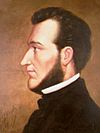 |
Brigadier General Francisco Morazán (1792–1842) Provisional Governor |
— | 3 April 1832 | 13 May 1832 | 40 days | Liberal/Military | Colonel Joaquín de San Martín |
|||
| 11 |  |
Colonel Joaquín de San Martín (1770–1854) |
— | 13 May 1832 | 25 July 1832 | 73 days | Liberal/Military | Office vacant | |||
| 12 |  |
Mariano Prado (1776–1837) |
— | 25 July 1832 | 1 July 1833 | 341 days | Liberal | Colonel Joaquín de San Martín |
|||
| 13 |  |
Colonel Joaquín de San Martín (1770–1854) |
1833 | 1 July 1833 | 23 June 1834 | 357 days | Liberal/Military | Colonel Lorenzo González |
|||
| – |  |
Brigadier General Carlos Salazar Castro (1800–1867) Provisional Governor |
— | 23 June 1834 | 13 July 1834 | 20 days | Military | Office vacant | |||
| – |  |
José Gregorio Salazar (1773–1838) Provisional Governor |
— | 13 July 1834 | 30 September 1834 | 79 days | Independent | ||||
| – | 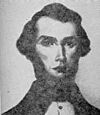 |
Joaquín Escolán y Balibrera (?–?) Provisional Governor |
— | 30 September 1834 | 14 October 1834 | 14 days | Independent | José María Silva | |||
| – |  |
José María Silva (1804–1876) Acting Governor |
— | 14 October 1834 | 2 March 1835 | 139 days | Independent | ||||
| – |  |
Joaquín Escolán y Balibrera (?–?) Acting Governor |
— | 2 March 1835 | 10 April 1835 | 39 days | Independent | Office vacant | |||
| 14 |  |
Brigadier General Nicolás Espinoza (1795–1845) |
1835 | 10 April 1835 | 15 November 1835 | 219 days | Liberal/Military | José María Silva | |||
| – |  |
Colonel Francisco Gómez (1796–1838) Acting Governor |
— | 15 November 1835 | 1 February 1836 | 78 days | Independent/Military | Office vacant | |||
| 15 |  |
Diego Vigil (1799–1845) |
— | 1 February 1836 | 23 May 1837 | 1 year, 111 days | Liberal | Timoteo Menéndez | |||
| – |  |
Timoteo Menéndez (?–?) Acting Governor |
— | 23 May 1837 | 7 June 1837 | 15 days | Independent | ||||
| 16 |  |
Diego Vigil (1799–1845) |
— | 7 June 1837 | 6 January 1838 | 213 days | Liberal | ||||
| – |  |
Timoteo Menéndez (?–?) Acting Governor |
— | 6 January 1838 | 23 May 1839 | 1 year, 137 days | Independent | ||||
| – |  |
Colonel Antonio José Cañas (1785–1844) Acting Governor |
— | 23 May 1839 | 11 July 1839 | 49 days | Military | Office vacant | |||
| 17 |  |
Brigadier General Francisco Morazán (1792–1842) |
— | 11 July 1839 | 16 February 1840 | 40 days | Liberal/Military | José María Silva | |||
| – |  |
José María Silva (1804–1876) Acting Governor |
— | 16 February 1840 | 5 April 1840 | 49 days | Independent | ||||
| – |  |
Municipal Council of San Salvador | — | 5 April 1840 | 7 April 1840 | 2 days | Independent | Office vacant | |||
| – |  |
Colonel Antonio José Cañas (1785–1844) Acting Governor |
— | 7 April 1840 | 20 September 1840 | 166 days | Military | ||||
| – |  |
Norberto Ramírez (1802–1856) Acting Governor |
— | 20 September 1840 | 7 January 1841 | 109 days | Independent | ||||
| – |  |
Juan Lindo (1790–1857) Provisional Governor |
— | 7 January 1841 | 30 January 1841 | 23 days | Conservative | Pedro José Arce | |||
| – |  |
Juan Lindo (1790–1857) Provisional President |
— | 30 January 1841 | 20 June 1841 | 141 days | Conservative | Pedro José Arce | |||
| – | 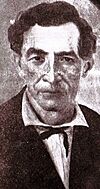 |
Pedro José Arce (1801–1871) Acting President |
— | 20 June 1841 | 28 June 1841 | 8 days | Independent | ||||
| 18 |  |
Juan Lindo (1790–1857) |
— | 28 June 1841 | 1 February 1842 | 218 days | Conservative | ||||
| – |  |
Brigadier General José Escolástico Marín (?–1846) Acting President |
— | 1 February 1842 | 12 April 1842 | 70 days | Military | Office vacant | |||
| 19 |  |
Brigadier General Juan José Guzmán (1797–1847) |
— | 12 April 1842 | 30 June 1842 | 79 days | Conservative/Military | Pedro José Arce | |||
| – |  |
Dionisio Villacorta (?–1846) Acting President |
— | 30 June 1842 | 19 July 1842 | 19 days | Independent | ||||
| – |  |
Brigadier General José Escolástico Marín (?–1846) Acting President |
— | 19 July 1842 | 26 September 1842 | 69 days | Military | ||||
| 20 |  |
Brigadier General Juan José Guzmán (1797–1847) |
— | 26 September 1842 | 26 January 1843 | 122 days | Conservative/Military | ||||
| – |  |
Pedro José Arce (1801–1871) Acting President |
— | 26 January 1843 | 8 March 1843 | 41 days | Independent | ||||
| 21 |  |
Brigadier General Juan José Guzmán (1797–1847) |
— | 8 March 1843 | 31 January 1844 | 329 days | Conservative/Military | ||||
| – |  |
Fermín Palacios (?–?) Acting President |
— | 1 February 1844 | 7 February 1844 | 6 days | Independent | Office vacant | |||
| 22 |  |
Brigadier General Francisco Malespín (1806–1846) |
1844 | 7 February 1844 | 9 May 1844 | 92 days | Conservative/Military | Luis Ayala | |||
| Brigadier General Joaquín Eufrasio Guzmán |
|||||||||||
| – |  |
Brigadier General Joaquín Eufrasio Guzmán (1801–1875) Acting President |
— | 9 May 1844 | 16 June 1844 | 38 days | Conservative | ||||
| 23 |  |
Brigadier General Francisco Malespín (1806–1846) |
— | 16 June 1844 | 25 October 1844 | 131 days | Conservative/Military | ||||
| – |  |
Brigadier General Joaquín Eufrasio Guzmán (1801–1875) Acting President |
— | 25 October 1844 | 16 February 1845 | 114 days | Conservative | ||||
| – |  |
Fermín Palacios (?–?) Acting President |
— | 16 February 1845 | 25 April 1845 | 68 days | Independent | ||||
| – |  |
Brigadier General Joaquín Eufrasio Guzmán (1801–1875) Acting President |
— | 25 April 1845 | 1 February 1846 | 282 days | Conservative | ||||
| – |  |
Fermín Palacios (?–?) Acting President |
— | 1 February 1846 | 21 February 1846 | 20 days | Independent | Office vacant | |||
| 24 | 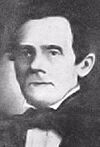 |
Doctor Eugenio Aguilar (1804–1879) |
1846 | 21 February 1846 | 12 July 1846 | 141 days | Liberal | José Campo | |||
| – |  |
Fermín Palacios (?–?) Acting President |
— | 12 July 1846 | 21 July 1846 | 9 days | Independent | ||||
| 25 |  |
Doctor Eugenio Aguilar (1804–1879) |
— | 21 July 1846 | 1 February 1848 | 1 year, 195 days | Liberal | ||||
| – | 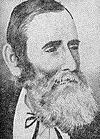 |
Tomás Medina (1803–1884) Acting President |
— | 1 February 1848 | 3 February 1848 | 2 days | Independent | Office vacant | |||
| – | 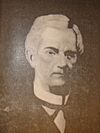 |
José Félix Quirós (1811–1883) Acting President |
— | 3 February 1848 | 7 February 1848 | 4 days | Independent | José Félix Quirós | |||
| 26 |  |
Doroteo Vasconcelos (1803–1883) |
1848 | 7 February 1848 | 26 January 1850 | 1 year, 353 days | Liberal | ||||
| – |  |
Ramón Rodríguez (1803–1884) Acting President |
— | 26 January 1850 | 1 February 1850 | 6 days | Independent | ||||
| – |  |
José Félix Quirós (1811–1883) Acting President |
— | 1 February 1850 | 4 February 1850 | 3 days | Independent | ||||
| 27 |  |
Doroteo Vasconcelos (1803–1883) |
1850 | 4 February 1850 | 12 January 1851 | 342 days | Liberal | ||||
| – |  |
Francisco Dueñas (1810–1884) Acting President |
— | 12 January 1851 | 19 March 1851 | 66 days | Conservative | ||||
| – |  |
José Félix Quirós (1811–1883) Acting President |
— | 19 March 1851 | 3 May 1851 | 45 days | Independent | ||||
| – |  |
Francisco Dueñas (1810–1884) Acting President |
— | 3 May 1851 | 30 January 1852 | 272 days | Conservative | ||||
| – |  |
Colonel José María San Martín (1811–1857) Acting President |
— | 30 January 1852 | 1 February 1852 | 2 days | Conservative/Military | ||||
| 28 |  |
Francisco Dueñas (1810–1884) |
1852 | 1 February 1852 | 1 February 1854 | 2 years, 0 days | Conservative | Tomás Medina | |||
| – |  |
Vicente Gómez (?–?) Acting President |
— | 1 February 1854 | 15 February 1854 | 14 days | Independent | Brigadier General José Mariano Hernández |
|||
| 29 |  |
Colonel José María San Martín (1811–1857) |
1854 | 15 February 1854 | 26 September 1854 | 223 days | Conservative/Military | ||||
| – |  |
Brigadier General José Mariano Hernández (1786–1864) Acting President |
— | 26 September 1854 | 13 November 1854 | 48 days | Conservative/Military | ||||
| 30 |  |
Colonel José María San Martín (1811–1857) |
— | 13 November 1854 | 1 February 1856 | 1 year, 80 days | Conservative/Military | ||||
| – |  |
Francisco Dueñas (1810–1884) Acting President |
— | 1 February 1856 | 12 February 1856 | 11 days | Conservative | Francisco Dueñas | |||
| 31 |  |
Rafael Campo (1813–1890) |
1856 | 12 February 1856 | 12 May 1856 | 90 days | Conservative | ||||
| – |  |
Francisco Dueñas (1810–1884) Acting President |
— | 12 May 1856 | 19 July 1856 | 68 days | Conservative | ||||
| 32 |  |
Rafael Campo (1813–1890) |
— | 19 July 1856 | 1 February 1858 | 1 year, 197 days | Conservative | ||||
| – | 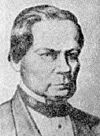 |
Lorenzo Zepeda (?–?) Acting President |
— | 1 February 1858 | 7 February 1858 | 6 days | Independent | Office vacant | |||
| 33 |  |
Brigadier General Miguel Santín del Castillo (1830–1880) |
1858 | 7 February 1858 | 24 June 1858 | 137 days | Conservative | Brigadier General Joaquín Eufrasio Guzmán |
|||
| – |  |
Captain General Gerardo Barrios (1813–1865) Acting President |
— | 24 June 1858 | 16 September 1858 | 84 days | Liberal | ||||
| 34 |  |
Brigadier General Miguel Santín del Castillo (1830–1880) |
— | 16 September 1858 | 19 January 1859 | 125 days | Conservative | ||||
| – |  |
Brigadier General Joaquín Eufrasio Guzmán (1801–1875) Acting President |
— | 19 January 1859 | 15 February 1859 | 27 days | Conservative | ||||
| – |  |
José María Peralta (1807–1883) Acting President |
— | 15 February 1859 | 12 March 1859 | 25 days | Independent | Office vacant | |||
| – |  |
Captain General Gerardo Barrios (1813–1865) Acting President |
— | 12 March 1859 | 1 February 1860 | 326 days | Liberal | ||||
| 35 |  |
Captain General Gerardo Barrios (1813–1865) |
1859 | 1 February 1860 | 16 December 1860 | 319 days | Liberal | José Félix Quirós | |||
| – |  |
José María Peralta (1807–1883) Acting President |
— | 16 December 1860 | 7 February 1861 | 53 days | Independent | ||||
| 36 |  |
Captain General Gerardo Barrios (1813–1865) |
— | 7 February 1861 | 26 October 1863 | 2 years, 261 days | Liberal | ||||
| – |  |
Francisco Dueñas (1810–1884) Provisional President |
— | 26 October 1863 | 1 February 1865 | 1 year, 98 days | Conservative | Office vacant | |||
| 37 |  |
Francisco Dueñas (1810–1884) |
1864 1869 |
1 February 1865 | 12 April 1871 | 6 years, 70 days | Conservative | Gregorio Arbizú | |||
| José María Parrilla | |||||||||||
| – |  |
Marshal Santiago González (1818–1887) Provisional President |
— | 12 April 1871 | 1 February 1872 | 295 days | Liberal/Military | Office vacant | |||
| 38 |  |
Marshal Santiago González (1818–1887) |
1872 | 1 February 1872 | 10 May 1872 | 99 days | Liberal/Military | Manuel Méndez | |||
| – |  |
Manuel Méndez (?–1872) Acting President |
— | 10 May 1872 | 9 July 1872 | 122 days | Independent | ||||
| 39 |  |
Marshal Santiago González (1818–1887) |
— | 9 July 1872 | 1 February 1876 | 3 years, 145 days | Liberal/Military | Office vacant | |||
| 40 | 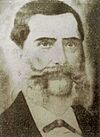 |
Andrés del Valle (1833–1888) |
Jan. 1876 | 1 February 1876 | 1 May 1876 | 90 days | Liberal | Santiago González | |||
| – |  |
Doctor Rafael Zaldívar (1834–1903) Provisional President |
— | 1 May 1876 | 1 February 1880 | 3 years, 276 days | Liberal | Office vacant | |||
| 41 |  |
Doctor Rafael Zaldívar (1834–1903) |
Jun. 1876 | 1 February 1880 | 6 April 1884 | 4 years, 65 days | Liberal | ||||
| – |  |
Ángel Guirola (1826–1910) Acting President |
— | 6 April 1884 | 21 August 1884 | 4 years, 202 days | Independent | ||||
| 42 |  |
Doctor Rafael Zaldívar (1834–1903) |
— | 21 August 1884 | 14 May 1885 | 266 days | Liberal | ||||
| – |  |
Divisional General Fernando Figueroa (1849–1919) |
— | 14 May 1885 | 18 June 1885 | 35 days | Liberal/Military | ||||
| – |  |
José Rosales Herrador (1827–1891) Provisional President |
— | 18 June 1885 | 22 June 1885 | 4 days | Independent | ||||
| – |  |
Brigadier General Francisco Menéndez (1830–1890) Provisional President |
— | 22 June 1885 | 1 March 1887 | 1 year, 252 days | Liberal/Military | ||||
| 43 |  |
Brigadier General Francisco Menéndez (1830–1890) |
1887 | 1 March 1887 | 22 June 1890 | 3 years, 113 days | Liberal/Military | ||||
| – |  |
Brigadier General Carlos Ezeta (1852–1903) Provisional President |
— | 22 June 1890 | 1 March 1891 | 252 days | Liberal/Military | ||||
| 44 |  |
Brigadier General Carlos Ezeta (1852–1903) |
1891 | 1 March 1891 | 10 June 1894 | 3 years, 101 days | Liberal/Military | Brigadier General Antonio Ezeta |
|||
| – |  |
Brigadier General Rafael Antonio Gutiérrez (1845–1921) Provisional President |
— | 10 June 1894 | 1 March 1895 | 264 days | Liberal/Military | Office vacant | |||
| 45 |  |
Brigadier General Rafael Antonio Gutiérrez (1845–1921) |
1895 | 1 March 1895 | 14 November 1898 | 3 years, 258 days | Liberal/Military | Prudencio Alfaro | |||
| – |  |
Brigadier General Tomás Regalado (1861–1906) Provisional President |
— | 14 November 1898 | 1 March 1899 | 107 days | Liberal/Military | Office vacant | |||
| 46 |  |
Brigadier General Tomás Regalado (1861–1906) |
1899 | 1 March 1899 | 1 March 1903 | 4 years, 0 days | Liberal/Military | Francisco Reyes | |||
| 47 | 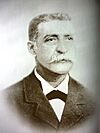 |
Brigadier General Pedro José Escalón (1847–1923) |
1903 | 1 March 1903 | 1 March 1907 | 4 years, 0 days | Conservative/Military | Calixto Velado Eduardo | |||
| 48 |  |
Divisional General Fernando Figueroa (1849–1919) |
1907 | 1 March 1907 | 1 March 1911 | 4 years, 0 days | Liberal/Military | Manuel Enrique Araujo | |||
| 49 |  |
Doctor Manuel Enrique Araujo (1865–1913) |
1911 | 1 March 1911 | 9 February 1913 | 1 year, 345 days | Liberal | Onofre Durán Santillana | |||
| – |  |
Carlos Meléndez (1861–1919) Provisional President |
— | 9 February 1913 | 29 August 1914 | 1 year, 201 days | Liberal | Office vacant | |||
| – |  |
Doctor Alfonso Quiñónez Molina (1874–1950) Provisional President |
— | 29 August 1914 | 1 March 1915 | 184 days | Liberal | ||||
| 50 |  |
Carlos Meléndez (1861–1919) |
1915 | 1 March 1915 | 21 December 1918 | 3 years, 295 days | Liberal | Alfonso Quiñónez Molina | |||
| – |  |
Doctor Alfonso Quiñónez Molina (1874–1950) Provisional President |
— | 21 December 1918 | 1 March 1919 | 70 days | National Democratic Party | Office vacant | |||
| 51 |  |
Jorge Meléndez (1871–1953) |
1919 | 1 March 1919 | 1 March 1923 | 4 years, 0 days | National Democratic Party | Alfonso Quiñónez Molina | |||
| 52 |  |
Doctor Alfonso Quiñónez Molina (1874–1950) |
1923 | 1 March 1923 | 1 March 1927 | 4 years, 0 days | National Democratic Party | Pío Romero Bosque | |||
| 53 |  |
Doctor Pío Romero Bosque (1860–1935) |
1927 | 1 March 1927 | 1 March 1931 | 4 years, 0 days | National Democratic Party | Gustavo Vides | |||
| 54 |  |
Arturo Araujo (1878–1967) |
1931 | 1 March 1931 | 2 December 1931 | 276 days | Salvadoran Laborist Party | Brigadier General Maximiliano Hernández Martínez |
|||
| – |  |
Civic Directory | — | 2 December 1931 | 4 December 1931 | 2 days | Military | ||||
| – |  |
Brigadier General Maximiliano Hernández Martínez (1882–1966) Provisional President |
— | 4 December 1931 | 28 August 1934 | 2 years, 267 days | Military | ||||
| – | 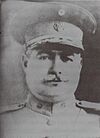 |
Brigadier General Andrés Ignacio Menéndez (1879–1962) Provisional President |
— | 28 August 1934 | 1 March 1935 | 185 days | National Pro Patria Party/Military |
Office vacant | |||
| 55 |  |
Brigadier General Maximiliano Hernández Martínez (1882–1966) |
1935 1939 1944 |
1 March 1935 | 9 May 1944 | 9 years, 69 days | National Pro Patria Party/Military |
||||
| – |  |
Brigadier General Andrés Ignacio Menéndez (1879–1962) Provisional President |
— | 9 May 1944 | 21 October 1944 | 165 days | National Pro Patria Party/Military |
||||
| – |  |
Colonel Osmín Aguirre y Salinas (1889–1977) Provisional President |
— | 21 October 1944 | 1 March 1945 | 131 days | Military | ||||
| 56 |  |
Brigadier General Salvador Castaneda Castro (1888–1965) |
1945 | 1 March 1945 | 14 December 1948 | 3 years, 288 days | Unification Social Democratic Party/Military |
Manuel Adriano Vilanova | |||
| – |  |
Revolutionary Council of Government | — | 14 December 1948 | 14 September 1950 | 1 year, 274 days | Military | Office vacant | |||
| 57 |  |
Lieutenant Colonel Óscar Osorio (1910–1969) |
1950 | 14 September 1950 | 14 September 1956 | 6 years, 0 days | Revolutionary Party of Democratic Unification/Military |
José María Peralta | |||
| 58 |  |
Lieutenant Colonel José María Lemus (1911–1993) |
1956 | 14 September 1956 | 26 October 1960 | 4 years, 42 days | Revolutionary Party of Democratic Unification/Military |
Humberto Costa | |||
| – |  |
Junta of Government | — | 26 October 1960 | 25 January 1961 | 91 days | Military | Office vacant | |||
| – |  |
Civic-Military Directory | — | 25 January 1961 | 25 January 1962 | 1 year, 0 days | Military | ||||
| – |  |
Doctor Eusebio Rodolfo Cordón Cea (1899–1966) Provisional President |
— | 25 January 1962 | 1 July 1962 | 157 days | Independent | ||||
| 59 |  |
Lieutenant Colonel Julio Adalberto Rivera (1921–1973) |
1962 | 1 July 1962 | 1 July 1967 | 5 years, 0 days | National Conciliation Party/Military |
Francisco Roberto Lima | |||
| 60 |  |
Brigadier General Fidel Sánchez Hernández (1917–2003) |
1967 | 1 July 1967 | 1 July 1972 | 5 years, 0 days | National Conciliation Party/Military |
Humberto Guillermo Cuestas | |||
| 61 |  |
Colonel Arturo Armando Molina (1927–2021) |
1972 | 1 July 1972 | 1 July 1977 | 5 years, 0 days | National Conciliation Party/Military |
Enrique Mayorga Rivas | |||
| 62 |  |
Brigadier General Carlos Humberto Romero (1924–2017) |
1977 | 1 July 1977 | 15 October 1979 | 2 years, 106 days | National Conciliation Party/Military |
Julio Astacio | |||
| – |  |
Revolutionary Government Junta | — | 15 October 1979 | 2 May 1982 | 2 years, 199 days | Military | Office vacant | |||
| 63 |  |
Doctor Álvaro Magaña (1925–2001) |
1982 | 2 May 1982 | 1 June 1984 | 2 years, 30 days | Independent | Raúl Molina Martínez | |||
| Mauricio Gutiérrez Castro | |||||||||||
| Pablo Mauricio Alvergue | |||||||||||
| 64 |  |
José Napoleón Duarte (1925–1990) |
1984 | 1 June 1984 | 1 June 1989 | 5 years, 0 days | Christian Democratic Party | Rodolfo Castillo | |||
| 65 |  |
Alfredo Cristiani (born 1947) |
1989 | 1 June 1989 | 1 June 1994 | 5 years, 0 days | Nationalist Republican Alliance |
José Francisco Merino | |||
| 66 |  |
Doctor Armando Calderón Sol (1948–2017) |
1994 | 1 June 1994 | 1 June 1999 | 5 years, 0 days | Nationalist Republican Alliance |
Enrique Borgo Bustamante | |||
| 67 |  |
Francisco Flores Pérez (1959–2016) |
1999 | 1 June 1999 | 1 June 2004 | 5 years, 0 days | Nationalist Republican Alliance |
Carlos Quintanilla Schmidt | |||
| 68 | 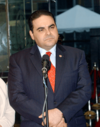 |
Antonio Saca (born 1965) |
2004 | 1 June 2004 | 1 June 2009 | 5 years, 0 days | Nationalist Republican Alliance |
Ana Vilma de Escobar | |||
| 69 |  |
Mauricio Funes (1959–2025) |
2009 | 1 June 2009 | 1 June 2014 | 5 years, 0 days | Farabundo Martí National Liberation Front |
Salvador Sánchez Cerén | |||
| 70 |  |
Salvador Sánchez Cerén (born 1944) |
2014 | 1 June 2014 | 1 June 2019 | 5 years, 0 days | Farabundo Martí National Liberation Front |
Óscar Ortiz | |||
| 71 |  |
Nayib Bukele (born 1981) |
2019 2024 |
1 June 2019 | Incumbent | 5 years, 329 days | Grand Alliance for National Unity |
Félix Ulloa | |||
| Nuevas Ideas | |||||||||||
| – |  |
Claudia Rodríguez de Guevara (born 1980/1981) Acting President |
— | 1 December 2023 | 1 June 2024 | 183 days | Nuevas Ideas | ||||
Timeline
The following timeline visualizes the presidencies of El Salvador since 1821.

Latest election
| Candidate | Running mate | Party | Votes | % | |
|---|---|---|---|---|---|
| Nayib Bukele | Félix Ulloa | Nuevas Ideas | 2,701,725 | 84.65 | |
| Manuel Flores | Werner Marroquín | Farabundo Martí National Liberation Front | 204,167 | 6.40 | |
| Joel Sánchez | Hilcia Bonilla | Nationalist Republican Alliance | 177,881 | 5.57 | |
| Luis Parada | Celia Medrano | Nuestro Tiempo | 65,076 | 2.04 | |
| Javier Renderos | Rafael Montalvo | Solidary Force | 23,473 | 0.74 | |
| Marina Murillo | Fausto Carranza | Salvadoran Patriotic Fraternity | 19,293 | 0.60 | |
| Total | 3,191,615 | 100.00 | |||
| Valid votes | 3,191,615 | 97.65 | |||
| Invalid votes | 61,787 | 1.89 | |||
| Blank votes | 15,064 | 0.46 | |||
| Total votes | 3,268,466 | 100.00 | |||
| Registered voters/turnout | 6,214,399 | 52.60 | |||
See also
 In Spanish: Presidente de El Salvador para niños
In Spanish: Presidente de El Salvador para niños
- Colonial Intendant of San Salvador


